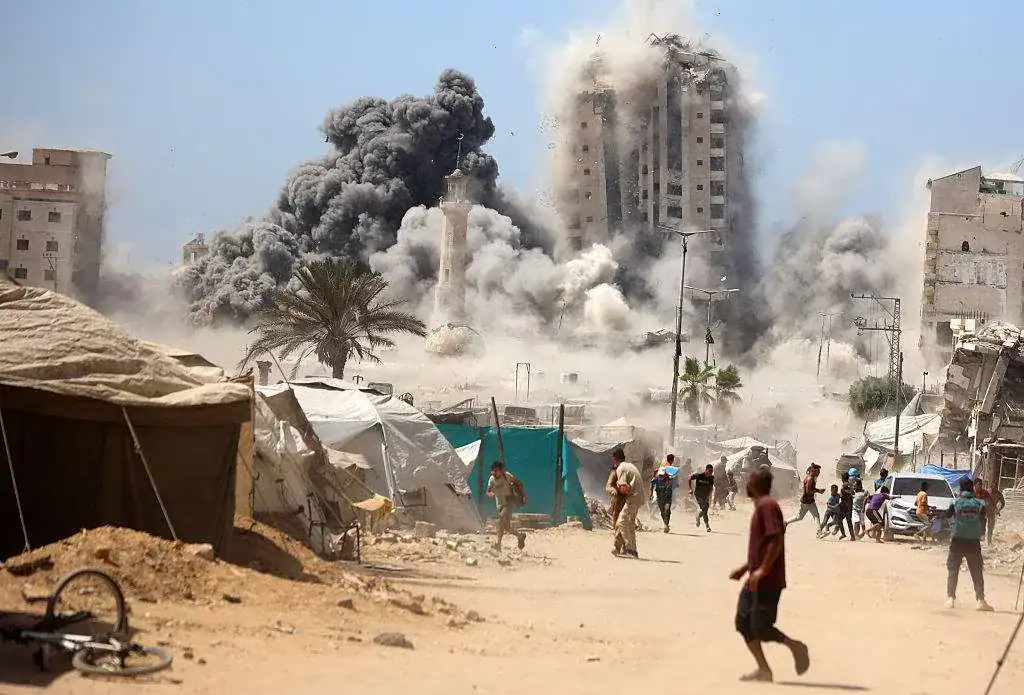Israeli military Gaza City offensive escalates with warning
The Israeli military Gaza City offensive has entered a dangerous new phase. On Friday, Israeli forces warned residents of Gaza City to evacuate southwards, cautioning that operations in the urban center would be carried out with “unprecedented force.” The announcement reflects both the scale of the ongoing Gaza conflict and the rising humanitarian crisis caused by the escalating ground offensive.
For civilians in Gaza, the warning is stark: leave immediately or face the risks of a military campaign in one of the most densely populated areas in the region. The push southward is part of Israel’s strategy to dismantle Hamas networks while minimizing urban combat risks, yet the sheer number of displaced families highlights the enormous challenges of civilian evacuation.
Ground offensive reshapes Gaza conflict
The ground offensive in Gaza City marks one of the most significant escalations since hostilities resumed earlier this year. Israeli commanders describe Gaza City as the heart of Hamas’ operations, including tunnels, command centers, and weapon stockpiles. By advancing into this stronghold, the Israeli military seeks to cripple Hamas’ capacity to launch rockets and coordinate attacks.
Yet military analysts caution that the Gaza conflict is entering an unpredictable stage. Urban warfare is notoriously difficult, and Gaza City—with its dense neighborhoods, narrow streets, and underground infrastructure—presents enormous tactical challenges. The use of “unprecedented force” signals Israel’s determination to avoid a drawn-out battle, but it also raises fears of severe civilian casualties.
Civilian evacuation at the center of the crisis
At the core of the Israeli military Gaza City offensive is the urgent issue of civilian evacuation. Thousands of families are being urged to leave their homes and move southward, often with little more than what they can carry. Aid organizations warn that humanitarian corridors are overcrowded and under-resourced, leaving many people vulnerable.
The United Nations and international NGOs have appealed to both sides to protect civilians. However, reports suggest that many residents are hesitant to leave, fearing that evacuation zones may not guarantee safety or that they may never return to their homes. This underscores the devastating human cost of the ongoing Gaza conflict.
The Israeli military strategy and its implications
The Israeli military’s strategy in Gaza City combines airstrikes, artillery fire, and targeted ground movements. Officials argue that dismantling Hamas’ infrastructure requires decisive action, and Gaza City—long regarded as Hamas’ operational hub—is central to this effort.
Israeli Defense Forces (IDF) spokespeople emphasize that warnings are designed to limit civilian harm, encouraging evacuation before the main assault begins. Still, critics point out that in such a densely populated region, even advance warnings may not prevent significant casualties.
For Israel, the ground offensive is also about sending a political message: demonstrating strength, securing deterrence, and reassuring its citizens that security threats will be addressed. For Palestinians, however, the offensive deepens an already catastrophic humanitarian emergency.
Gaza conflict on the international stage
The Israeli military Gaza City offensive has drawn widespread attention from the international community. Governments and humanitarian agencies worldwide have expressed concern over the escalating violence. Some Western nations reaffirm Israel’s right to defend itself, while others call for restraint to avoid worsening civilian suffering.
The Gaza conflict has long been a flashpoint for regional instability. Egypt, Qatar, and the United States are reportedly working behind the scenes to negotiate pauses or safe corridors, though progress remains slow. Meanwhile, regional powers warn that prolonged escalation could trigger broader unrest beyond Gaza’s borders.
Civilian voices from Gaza City
For the people of Gaza City, the ground offensive is more than a headline—it’s a daily struggle for survival. Families report hearing constant shelling and witnessing destruction in residential neighborhoods. Many have fled, while others remain trapped by lack of transport, resources, or safe passage.
One displaced resident told aid workers: “We were told to leave, but where do we go? Everywhere feels unsafe.” Such testimonies underscore the grim reality of civilian evacuation during conflict—choices between leaving homes behind and facing bombardment, or staying and risking their lives.
Humanitarian consequences of the offensive
The humanitarian toll of the Israeli military Gaza City offensive is rising. Hospitals already operating under strain now face shortages of medicine, fuel, and equipment. Aid groups highlight the difficulty of delivering supplies amid ongoing hostilities.
The displacement crisis is worsening. According to humanitarian estimates, tens of thousands are on the move each day. Families crowd into temporary shelters, schools, and makeshift camps, while food, clean water, and sanitation become harder to access. In this context, the phrase “civilian evacuation” takes on a devastating meaning, as it often equates to displacement without safety or certainty.
Military analysts: a long road ahead
Experts believe that while the Israeli military Gaza City offensive may achieve tactical gains, the broader challenges of the Gaza conflict remain unresolved. Hamas has long embedded itself within urban areas, making complete eradication difficult. Furthermore, urban combat tends to prolong conflicts, draining resources and escalating humanitarian costs.
For Israel, success will depend on balancing military objectives with international pressure and humanitarian considerations. For Palestinians, survival remains the immediate concern, overshadowing any political calculations.
Calls for ceasefire and restraint
Amid the intensifying ground offensive, global calls for a ceasefire or humanitarian pause are growing louder. The United Nations warns that failure to protect civilians could deepen instability in the region. Aid groups insist that safe corridors must be established to allow genuine civilian evacuation and delivery of life-saving assistance.
While some governments back Israel’s right to act, others stress that military solutions alone cannot resolve the Gaza conflict. Diplomatic negotiations remain critical, though reaching consensus between stakeholders remains difficult.
Conclusion: uncertain future for Gaza City
The Israeli military Gaza City offensive has placed the territory’s largest urban center at the heart of global attention. With “unprecedented force” promised, the stakes could not be higher—for Israel, for Hamas, and most importantly, for the civilians caught in the middle.
The offensive highlights the complex interplay of military strategy, political messaging, and humanitarian crisis. It underscores how ground offensive operations in urban environments intensify the risks for ordinary people, forcing mass civilian evacuation under dire conditions.
As the Gaza conflict deepens, the world watches closely, weighing Israel’s military goals against the unfolding humanitarian disaster. The road ahead for Gaza City is uncertain, and the long-term consequences of this offensive will likely shape regional dynamics for years to come.




